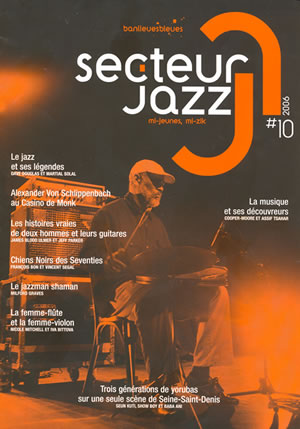Commentaries on Current Music Criticism
by
Bill Shoemaker
Standard Time
Time Magazine’s May 7 article, “7 Greatest Jazz CDs” is either six months early or late. It is the stuff of a generic holiday gift guide: compilations of Armstrong, Ellington, Holiday and Charlie Christian; the complete Massey Hall concert and Birth of the Cool sessions; and, A Love Supreme, the sole recording that is less than 50 years old. A line-up tailored for a co-op ad for Borders, it is the polar opposite of the sub headline’s claim: “A fearless pick of the hippest and coolest ever.” The sub’s call to “Let the arguments begin” is therefore absurd.
This is not to say that veteran Time arts editor Christopher Porterfield has nothing to say. He elegantly applies John Updike’s praise of Vladimir Nabokov’s ecstatic writing style to the Coltrane classic. His short takes on the albums are peppered with ear-tugging descriptions. Holiday’s “reedy, frayed-at-the-edges voice, teasingly lagging the beat, instinctively breathes the bittersweet essence of the jazz life.” But, with the exception of his the slightly eyebrow-raising assertion that Armstrong’s Hot Fives and Sevens “propelled jazz from a shambling, collective folk music into an art form,” Porterfield offers nothing that could possibly gain polemical traction.
Therein lies the irony of how the article is framed. It suggests that there is a vigorous debate about jazz, if only among partisans, then weighs in with a list that will cause all parties to shrug their shoulders, or even yawn. Still, the word count for the Magnificent Seven is comparable to Time articles covering various serious issues affecting millions of people. This begs the question: Are these more important issues being short-changed as jazz is in the present article? Probably. The fact remains, however, that the magazine’s coverage of many of those issues is occasional, if not ongoing, so there are later opportunities to fill in gaps and provide deeper context and analysis. That’s not the case with jazz. The quota has been met: that’s it for jazz in Time .., well, until the holidays, perhaps.
10 May
Youth Movement
Secteur Jazz is a hip rag. The editorial slant is right on. Features on Milford Graves, Nicole Mitchell, James Blood Ulmer … hell, Cooper-Moore’s on the cover. Given that it is produced by Banlieues Bleues, a spring festival held throughout the Paris suburbs, it’s not surprising. Year after year, Banlieues Bleues has one of the strongest, progressive lineups of any festival on the planet. What is not just surprising, but actually shocking, is that teenagers wrote the entire issue.
Critic Alexandre Pierrepont works with the Secteur Jazz staff of 15 to 18 years olds, who are recruited from two high schools in Paris’ northern suburbs, including Lycée Jacques Brel in La Courneuve, whose students live in the main housing projects around Paris. Though most of the students are from families who emigrated from Africa, the Middle East or Asia, nearly all of the student writers were born in France. They are academically engaged and smart enough to seize a unique opportunity afforded by Secteur Jazz, even though most of them knew nothing about jazz going into the project.

Pierrepont, author, longtime Impro Jazz contributor and co-founder of The Weavers, who publish occasional volumes of creative music-inspired creative writing, brings an anthropological perspective to his various projects, which is reflected in his approach to his version of Jazz 101 for the student writers. In a recent email, Pierrepont wrote that the course outline included “a history and an anthropology of the importance of the music, whatever the forms, for African American people. So: what's in the music? Music as Freedom, Sonic Freedom, Vocal Freedom, Rhythmic Freedom - rather than an explanation through styles and technics. I don't give names; I talk of a rainbow, a spectrum, a continuum, etc.; then the importance of their music, whatever the forms, with the idea that so many forms are now possible (Sonic Freedom), in the history of the arts and of the Western World. So: in the life of everybody, in their own life, they now have to make new links by themselves; then, and only then, they are introduced to some more precise forms and to the artists they would have to meet. Before that, we listened to a lot of stuff, including ‘some other stuff.’ I remember when we listened to Leadbelly, Olu Dara with Charles Brackeen and with Nas, in a row. A lot of question and answer games during the class.
“Time is a big factor. We start in January, just after the New Year, and I meet them once a week until March. But now's the time to listen to the artists they will meet: we also burn copies of their CDs for them to listen to at home, they have some research to do around some topics, depending of the groups (like: "composition/improvisation" / "spontaneous composition/structured improvisation"). All the writing is made at the end, around the day of the concert."
Pierrepont’s idiosyncratic approach yields professional results. Even picky American high school French teachers can’t find a hair to split in terms of the students’ grammar or usage; it is also refreshingly free of jargon and slang. Still, it is their interview questions that are really remarkable. No adult would ask the duo of pianist Martial Solal and trumpeter Dave Douglas, who is more than thirty year’s Solal’s junior, if their age difference was an issue for them. It may seem like a naïve question, but it sparked an interesting response from the artists about how music and creativity bridged such categories. And, young people have a different circuitry for associative language, born out when guitarist James Blood Ulmer is asked about the link between the "devil" in blues music and the "daemon," which in Greek philosophy is another name for inspiration.
US institutions and media outlets concerned with reaching young people should take note of Secteur Jazz.
May 20
